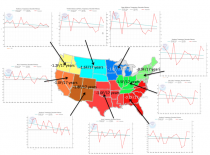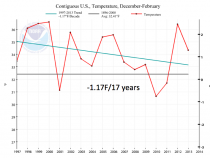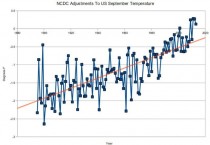Steve Goddard, Real Science
The EU’s Envisat satellite used to agree with tide gauges that there isn’t a lot of sea level rise going on.
But that just wouldn’t do anything to scare people, so one night they simply quadrupled sea level rise.
The graph below shows how they lowered past sea level, and raised recent sea level to create the EU mandated scary appearance of sea level rising.
-----
And as for the NOAA GHCN and the derivative NASA tampering Steve posts this:
Thirteen Years Of NASA Data Tampering In Six Seconds
Posted on December 21, 2013 by stevengoddard
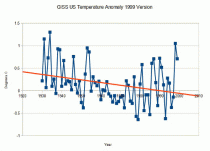
If it doesn’t animate go here.
The animation above shows four versions of GISS 1930-1999 US temperatures from 1999, 2001, 2012, and 2013. NASA has repeatedly tampered* with the data to hide the decline in US temperatures since the 1930’s. Each successive alteration makes the past cooler and the present warmer.
Earlier versions showed even more of a decline, but I can’t locate digital data for them.
*Mosher says these adjustments are all first rate science.
The Scientific Alliance
There are certain basics which we need to stay alive. For any animal, food and water top that list, since survival is impossible without them, but sufficient warmth and shelter come a close second. The needs of hunter/gatherer communities are much the same as for groups of animals with similar diets, although the use of fire increases the range of foods consumed.
The emergence of farming allowed larger settlements to develop, although food security was by no means guaranteed. Even today, with an enormous variety of food available to the great majority of the population of the developed world for the first time in history, around one billion people, principally in South Asia and sub-Saharan Africa, are chronically undernourished.
Should we conclude, therefore, that food security is the biggest issue facing the world today? For the remaining bands of hunter/gatherers, it is certainly the key focus of their existence. But the great majority of those who go to bed hungry do not rely on game animals or wild plants; they are either subsistence farmers or the urban poor. In the first case, they are dependent on the success of their own harvests and do not have the money to buy additional food (nor, in many cases, the opportunity). For the urban poor, the problem is purely and simply a lack of money.
So, although food remains at the apex of the pyramid of needs, what we should really be considering is what is needed to either grow more food or to become prosperous enough to be able to afford to buy it. And the answer is: energy. Food is itself energy for the human body. For those of us lucky enough to live in the industrialised world (and for the minority of kleptocrats in poor countries) the enjoyment of food is one of the pleasures of life, with entire industries growing up to supply our needs (food manufacturers, retailers, restaurants and celebrity chefs, for example). But, ultimately, we eat to stay alive and healthy and be able to work to grow more food or earn money to buy it.
Subsistence farmers have only their own muscle power and that of any animals they may own to till their fields, plant, tend, weed and harvest their crops. This is a major constraint on both the area of land they can manage and the harvest they can expect from it. Yield is further limited by the availability of key nutrients: particularly nitrogen, but also potassium and phosphorus. So it was also in Europe until the industrial era.
Then the availability of steam power began an extended process of replacing the horse or ox (themselves offering a considerable advantage over puny humans) by the tractor. The invention of the Haber-Bosch process and its first commercial-scale use one hundred years ago made synthetic nitrogen fertilizers widely available and greatly increased the yield potential of existing land.
Nowadays, a relative handful of people grow much more food than produced from the same area at a time when the majority of people worked on the land. Rapid urbanisation in developing countries will mean that, before too long, agriculture will be a minor part of the economy of nearly every country, rather than being one of the largest sectors as at present for much of sub-Saharan Africa and South and South East Asia. But this seemingly unstoppable process of development can only continue if there is a reliable and affordable supply of energy to replace muscle power.
This is why, despite its engagement with the travelling circus that is the ongoing round of climate change negotiations, China will not be stopping building new power stations anytime soon. As some will point out, the country is installing lots of wind farms and solar panels but, in a country with such enormous energy needs, these pale into virtual insignificance compared to the coal-fired and nuclear capacity being installed.
According to a recently-posted web article (ChinaFAQs: Renewable Energy in China, An Overview), the country gets about 8% of total primary energy from non-fossil sources. However, much of this is hydroelectricity: it has nearly 230GW of installed capacity (the largest of any country), compared to 75GW of wind and just 7GW of solar PV. China may be the world’s largest producer of PV cells (many of which are exported) and plans many more wind farms, but this does not represent a shift away from fossil fuels.
An article in the Guardian from late last year tells the story: More than 1,000 new coal plants planned worldwide, figures show. The World Resources Institute found that 1,200 coal stations were being planned, about two-thirds of them in China and India. Some coal-fired plants in Beijing are being replaced by gas-fired ones, in a bid to reduce the capital’s notorious air pollution problem, but it seems clear that China and India are set for coal-fired growth for the next few decades.
China’s main comparative advantage is in low-cost manufacturing and this will not be compromised by raising energy prices unnecessarily. India, although with a less dynamic economy than its northern neighbour, can really only boost growth by exploiting similar labour cost advantages. And only by growing the economy will it be able to reduce the shockingly high level of undernourishment across the country.
Cheap and secure energy is the key to economic growth and productive farming. It is also, ultimately, the answer to the growing problem of fresh water scarcity. Water per se is not a limiting resource, but it is often either in the wrong place or too saline to use. A secure and expandable energy supply enables reverse osmosis to purify seawater, as well as powering more intelligent irrigation systems.
Global warming may or may not cause problems later this century, but a prosperous, well-fed population will be in a much better position to deal with this than a world where a billion people remain malnourished. Energy security is today’s imperative.
By Madhav Khandekar, Excerpt from Special Reports on Extremes
Have cold weather extremes been on the rise in recent years? A quick survey of weather extremes since the millennium seems to suggest this may be the ‘new’ reality of climate change. The northern hemisphere has witnessed four severe winters (2002/03, 2005/06, 2007/08, 2009/10) since 2000, with the European continent bearing the brunt of the cold weather. The severity of winter 2002/03 was felt all the way to south Asia, where hundreds of people in Vietnam and Bangladesh were reported to have died due to exposure to colder weather (due to lack of adequate heating in residential houses).
The winter of 2011/12 was quite severe, especially the month of February 2012 when minimum temperatures in parts of eastern Europe plunged to -40C in some locales, leading to several hundred deaths. The winter of 2012/13 was also colder than normal, with March 2013 setting record-breaking low temperatures in the UK, Berlin and parts of eastern Germany. Over North America, the winters of 2002/03, 2007/08 and 2009/10 were
significantly colder and snowier than normal and were linked to an extreme negative phase of the North Atlantic Oscillation, a slow-varying large-scale atmospheric flow pattern (Seager et al. 2010). Winter severity has also increased in northern India in recent years, where several hundred deaths (mostly of elderly people living in houses with no heat or insulation) have been reported in the last five years.
Several papers published in the last three years (Benestad 2010; Cattiaux et al. 2010; Lockwood et al. 2010) have linked the cold European winters of the last ten years to low solar activity (see NIPCC post on ‘Extreme cold winters over Europe’, dated 12 February 2012). Many solar scientists now suggest that winters in Europe could become even colder, as the sun enters a grand minimum in the next few years.
Besides Europe and North America, the entire continent of South America has seen colder winters over the last five years. The winters of 2007 (July in particular) and 2010 (June to July) were significantly colder than normal and several dozen deaths were reported in Argentina and Chile. Some locales in Argentina recorded low temperatures of −25C, and in July 2007 Buenos Aires recorded its first snowfall since 1918. The most recent winter (July 2013) saw snowfall at several dozen locales in Argentina, Chile and parts of southern Brazil (see Khandekar 2010, for a list of additional cold weather extremes).
It is of interest to note here the lack of news items on cold weather extremes in the media.
Most of the media seem to be obsessed with extremes of heat, completely ignoring cold weather extremes, despite these apparently being on the rise and despite the IPCC’s science failing to offer an explanation for them. In fact, the IPCC extreme weather events table projects ‘fewer cold days and frost in future’. It is also of interest to note here that most climate scientists and advocates of the global warming hypothesis have ignored the
‘cold’ reality of present climate change. The IPCC (2007) has discussed in some detail the European heatwave of summer 2003, but made no mention of the severely cold winter of 2002/03 and the deaths it caused in south Asia. The latest IPCC SPM AR5 released in Stockholm in September 2013 once again fails to mention increasing cold weather extremes of recent years.
Se support for the northern hemisphere winters cooling since 1995 here.
Also see the 17 year winter trends are negative for all 9 climate regions and the contiguous US.
Pierre Gosselin, No Tricks Zone
Perhaps you’ve been wondering why the alarmists have been so shrill lately? It’s not because the climate is overheating, to the contrary it’s beginning to cool and so their sham is about to be blown out into the open for everyone to see.

Austrian meteorological data show that European Alps have been cooling, at times massively, over the last 20 years. Public domain photo.
Evaluated data from the Austrian ZAMG meteorological institute now unmistakably show that the Alps have been cooling over the last 20 years and longer, “at some places massively” thus crassly contradicting all the loud claims, projections, and model scenarios made earlier by global warming scientists.
German meteorologist Dominik Jung reports on the data he himself evaluated from the European Alps and concludes at the German-language Huffington Post here:
We are obviously very far away from milder winters. The trend actually is moving in the opposite direction! A few years ago climatologists advised winter sports locations in the Alps to reduce their investments in winter sports facilities’ because of the ever increasing mean temperatures, they soon would not be worth it. So we ask ourselves, which increasing temperatures are the ladies and gentlemen even talking about?”
Some places have seen “massive cooling”
According to an expert review conducted by the Zentralanstalt fur Meteorologie und Geodynamik (ZAMG), the Austrian state weather service, using weather data from the last 20 years or more: “Winters there indeed are shown to have gotten colder over the last 20 years, and in some places quite massively. The last two winters at Kitzbuhel were in fact the coldest of the last 20 years.”
Jung then writes that also four other high elevation stations in the Alps were assessed: Zugspitze in Germany, Schmittenhohe in Austria, Sonnblick in Austria and Santis in Switzerland. Result:
They all yielded the same amazing result: Winters in the Alps over the last decades have become significantly colder, the data show.”
Jung writes that data from extra long datasets from 20 to 30 years were examined, “just like climatologists always insist.”
Jung then informs readers that he asked the Austrian meteorological experts on site what they thought of the results. According to Jung, the reaction was either dead silence induced by shock, or attempts to downplay the results. Had the data shown warming instead, then of course we would be hearing just the opposite of silence and downplaying...we’d be hearing the hysterical screams of bloody climate murder!
Humiliated science
Jung speculates that the reason meteorologists and climatologists don’t want to hear about the results is because “it doesn’t fit with their world view.” After all, just a few years ago they were cocksure about their predictions of winters without snow and that skiing was only going to be possible at extremely high elevations. Science just possibly could not be humiliated to a greater extent.
Near the end of his Huffington Post essay, Jung comments that it appears that “climate warming has become a religion. Those belonging to it do not tolerate new findings”, even those that stem from solid observations and measurements.
Meteorologist Jung concludes that it’s almost scandalous that the responsible authorities are simply ignoring these findings.
-----
In the US, some at NOAA research and who authored the CCSP documents and support material for the EPA promised the same. The worst offender may be the Union of Concerned Scientists. They are not really scientists but environmental advocist. Unfortunately they have displaced the real scientists at the universities in many locations. The Universities have little regard for the truth but see their chances of getting funding with warmists on staff.
In a meeting in 2007 on Mt. Washington these UCS reps form the UNH and other locations advised the ski and sugar industry that AGW will destroy their industries. That winter set new record for snow in New England and across the US north to Alaska. Last year UCS testified to NH legislature promising the same. Record snows in February and March followed. We need to purge our universities of UCS members and replace with real scientists for our children’s sake. I give talks to college students. In one class, a student stood up after my lecture and said he was mad...not at me but at his school. He said he paid for two courses in climate science and never heard in class of many of the factors I discussed in that lecture. In another even larger school a real meteorologist/climatologist who teaches a course and in his section on climate takes a very balanced approach was told by the Environmental Scientist chair of the department if he wanted to continue to teach there he could only talk weather as in the climate section he was bringing up factors that he could not talk intelligently about. These friends are not isolated instances.
By Dr. Tim Ball
Guest essay by Dr. Tim Ball
Elaine Dewar spent several days with Maurice Strong at the UN and concluded in her book The Cloak of Green that, “Strong was using the U.N. as a platform to sell a global environment crisis and the Global Governance Agenda.” Strong conjectured about a small group of world leaders who decided the rich countries were “the principle risk to the world.” These countries refused to reduce their environmental impact. The leaders decided the only hope for the planet was for collapse of the industrialized nations and it was their responsibility to bring that about. Strong knew what to do. Create a false problem with false science and use bureaucrats to bypass politicians to close industry down and make developed countries pay.
Compare the industrialized nation to an internal combustion engine running on fossil fuel. You can stop the engine in two ways; cut off the fuel supply or plug the exhaust. Cutting off fuel supply is a political minefield. People quickly notice as all prices, especially food, increase. It’s easier to show the exhaust is causing irreparable environmental damage. This is why CO2 became the exclusive focus of the Intergovernmental Panel on Climate Change (IPCC). Process and method were orchestrated to single out CO2 and show it was causing runaway global warming.
In the 1980s I warned Environment Canada employee Henry Hengeveld that convincing a politician of an idea is a problem. Henry’s career involved promoting CO2 as a problem. I explained the bigger problem comes if you convince them and the claim is proved wrong. You either admit your error or hide the truth. Environment Canada and member nations of the IPCC chose to hide or obfuscate the truth.
1. IPCC Definition of Climate Change Was First Major Deception
People were deceived when the IPCC was created. Most believe it’s a government commission of inquiry studying all climate change. The actual definition from the United Nations Environment Program (article 1) of the United Nations Framework Convention on Climate Change (UNFCCC) limits them to only human causes.
“a change of climate which is attributed directly or indirectly to human activity that alters the composition of the global atmosphere and which is in addition to natural climate variability observed over considerable time periods.”
In another deception, they changed the definition used in the first three Reports (1990, 1995, 2001) in the 2007 Report. It’s a footnote in the Summary for Policymakers (SPM).
“Climate change in IPCC usage refers to any change in climate over time, whether due to natural variability or as a result of human activity. This usage differs from that in the United Nations Framework Convention on Climate Change, where climate change refers to a change of climate that is attributed directly or indirectly to human activity that alters the composition of the global atmosphere and that is in addition to natural climate variability observed over comparable time periods.”
It was not used because Reports are cumulative and to include natural variability required starting over completely.
It is impossible to determine the human contribution to climate change if you don"t know or understand natural (non-human) climate change. Professor Murray Salby showed how the human CO2 portion is of no consequence, that variation in natural sources of CO2 explains almost all annual changes. He showed that a 5% variation in these sources is more than the total annual human production.
2. IPCC Infer And Prove Rather than Disprove a Hypothesis
To make the process appear scientific a hypothesis was inferred based on the assumptions that,
* CO2 was a greenhouse gas (GHG) that slowed the escape of heat from the Earth.
* the heat was back-radiated to raise the global temperature.
* if CO2 increased global temperature would rise.
* CO2 would increase because of expanding industrial activity.
* the global temperature rise was inevitable.
To further assure the predetermined outcome the IPCC set out to prove rather than disprove the hypothesis as scientific methodology requires. As Karl Popper said,
It is the rule which says that the other rules of scientific procedure must be designed in such a way that they do not protect any statement in science against falsification.
The consistent and overwhelming pattern of the IPCC reveal misrepresentations of CO2. When an issue was raised by scientists performing their role as skeptics, instead of considering and testing its validity and efficacy the IPCC worked to divert, even creating some false explanations. False answers succeeded because most people didn’t know they were false.
3. CO2 Facts Unknown to Most But Problematic to IPCC.
Some basic facts about CO2 are unknown to most people and illustrate the discrepancies and differences between IPCC claims and what science knows.
* Natural levels of Carbon dioxide (CO2) are less than 0.04% of the total atmosphere and 0.4% of the total GHG. It is not the most important greenhouse gas.
* Water vapour is 95 percent of the GHG by volume. It is the most important greenhouse gas by far.
* Methane (CH4) is the other natural GHG demonized by the IPCC. It is only 0.000175 percent of atmospheric gases and 0.036 percent of GHG.
* Figure 1 from ABC news shows the false information. It’s achieved by considering a dry atmosphere.

Figure 1
* The percentages troubled the IPCC so they amplified the importance of CO2 by estimating the “contribution” per unit (Figure 2). The range of estimates effectively makes the measures meaningless, unless you have a political agenda. Wikipedia acknowledges “It is not possible to state that a certain gas causes an exact percentage of the greenhouse effect.”
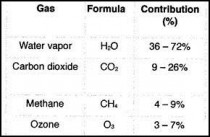
Figure 2 (Source Wikipedia)
4. Human CO2 production critical to IPCC objective so they control production of the information.
Here is their explanation.
What is the role of the IPCC in Greenhouse Gas inventories and reporting to the UNFCCC?
A: The IPCC has generated a number of methodology reports on national greenhouse gas inventories with a view to providing internationally acceptable inventory methodologies. The IPCC accepts the responsibility to provide scientific and technical advice on specific questions related to those inventory methods and practices that are contained in these reports, or at the request of the UNFCCC in accordance with established IPCC procedures. The IPCC has set up the Task Force on Inventories (TFI) to run the National Greenhouse Gas Inventory Programme (NGGIP) to produce this methodological advice. Parties to the UNFCCC have agreed to use the IPCC Guidelines in reporting to the convention.
How does the IPCC produce its inventory Guidelines? Utilising IPCC procedures, nominated experts from around the world draft the reports that are then extensively reviewed twice before approval by the IPCC. This process ensures that the widest possible range of views are incorporated into the documents.
They control the entire process from methodology, designation of technical advice, establishment of task forces, guidelines for reporting, nomination of experts to produce the reports, to final report approval. The figure they produce is a gross calculation, but it is estimated humans remove 50% of that amount.
Regardless, if you don’t know natural sources and variabilities of CO2 you cannot know the human portion. It was claimed the portion in the atmosphere from combustion of fossil fuels was known from the ratio of carbon isotopes C13/C12. Roy Spencer showed this was not the case. In addition, they ignore natural burning of fossil fuels including forest fires, long-burning coal seams and peat; as Hans Erren noted, fossil coal is buried wood. Spencer concluded,
If the C13/C12 relationship during NATURAL inter-annual variability is the same as that found for the trends, how can people claim that the trend signal is MANMADE??
The answer is, it was done to prove the hypothesis and further the deception.
5. Pressure For Urgent Political Action
Early IPCC Reports claimed the length of time CO2 remains in the atmosphere as very long. This implied it would continue as a problem even with immediate cessation of CO2 production. However as Segalstad wrote,
“Essenhigh (2009) points out that the IPCC (Intergovernmental Panel on Climate Change) in their first report (Houghton et al., 1990) gives an atmospheric CO2 residence time (lifetime) of 50-200 years [as a “rough estimate"]. This estimate is confusingly given as an adjustment time for a scenario with a given anthropogenic CO2 input, and ignores natural (sea and vegetation) CO2 flux rates. Such estimates are analytically invalid; and they are in conflict with the more correct explanation given elsewhere in the same IPCC report: This means that on average it takes only a few years before a CO2 molecule in the atmosphere is taken up by plants or dissolved in the ocean”.
6. Procedures to Hide Problems with IPCC Science And Heighten Alarmism.
IPCC procedures and mechanisms were established to deceive. IPCC has three Working Groups (WG). WGI produces the Physical Science Basis Report, which proves CO2 is the cause. WGII produces the Impacts, Adaptation and Vulnerability Report that is based on the result of WGI. WGIII produces the Mitigation of Climate Change Report. WGI and WGII accept WGI’s claim that warming is inevitable. They state,
Five criteria that should be met by climate scenarios if they are to be useful for impact researchers and policy makers are suggested: Criterion 1: Consistency with global projections. They should be consistent with a broad range of global warming projections based on increased concentrations of greenhouse gases. This range is variously cited as 1.4C to 5.8C by 2100, or 1.5C to 4.5C for a doubling of atmospheric CO2 concentration (otherwise known as the “equilibrium climate sensitivity").
They knew few would read or understand the Science Report with its admission of serious limitations. They deliberately delayed its release until after the Summary for Policymakers (SPM). As David Wojick explained,
Glaring omissions are only glaring to experts, so the “policymakers” - including the press and the public - who read the SPM will not realize they are being told only one side of a story. But the scientists who drafted the SPM know the truth, as revealed by the sometimes artful way they conceal it.
What is systematically omitted from the SPM are precisely the uncertainties and positive counter evidence that might negate the human interference theory. Instead of assessing these objections, the Summary confidently asserts just those findings that support its case. In short, this is advocacy, not assessment.
An example of this SPM deception occurred with the 1995 Report. The 1990 Report and the drafted 1995 Science Report said there was no evidence of a human effect. Benjamin Santer, as lead author of Chapter 8, changed the 1995 SPM for Chapter 8 drafted by his fellow authors that said,
“While some of the pattern-base discussed here have claimed detection of a significant climate change, no study to date has positively attributed all or part of climate change observed to man-made causes.”
to read,
“The body of statistical evidence in chapter 8, when examined in the context of our physical understanding of the climate system, now points to a discernible human influence on the global climate.”
The phrase “discernible human influence” became the headline as planned.
With AR5 (2013) they compounded the deception by releasing the SPM then releasing a correction. They got the headline they wanted. It is the same game as the difference between the exposure of problems in the WGI Science Report and the SPM. Media did not report the corrections, but the IPCC could now claim they detailed the inadequacy of their work. It’s not their fault that people don’t understand.
By Steve Goddard, Real Science
NOAA reported that September was the warmest ever on Earth, even though satellites showed September as being close to the median.
This tipped me off that they have gone into full cheating, damn the torpedoes mode. Check out the level of tampering they achieved for September US temperatures. NCDC shows a strong warming trend for September in the US.
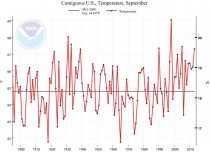
Enlarged http://www.ncdc.noaa.gov/cag/time-series/us/
But the actual thermometer data which they use shows a cooling trend.
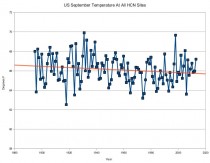
EnlargedIndex of /pub/data/ghcn/daily/hcn/
I immediately knew that we were looking at a record data tampering event. They have now passed two degrees of cheating in the US record. The graph below shows the difference between NCDC measured and reported data. As you can see, they are basically reducing temperatures from the past linearly with age.
NOAA has degenerated into a spectacularly immoral state, where their primary purpose seems to be to generate climate propaganda. Last week they were lying again about the 1,000 year rainfall in Colorado. It is pathetic.
Michael Bastasch
New estimates show the federal government will spend nearly twice as much fighting global warming this year than on U.S. border security.
The White House reported to House Republicans that there are 18 federal agencies engaged in global warming activities in 2013, funding a wide range of programs, including scientific research, international climate assistance, incentivizing renewable energy technology and subsidies to renewable energy producers. Global warming spending is estimated to cost $22.2 billion this year, and $21.4 billion next year.
At the same time, the federal government will spend nearly $12 billion on customs and border enforcement this year.
Obama’s climate agenda has attracted criticism from congressional Republicans who have been hammering the administration over the accountability and transparency of its global warming efforts.
Republicans on the Energy and Commerce Committee have been calling on the heads of major federal agencies to testify on global warming activities. So far, only the heads of the Energy Department and the Environmental Protection Agency have opted to testify in front of the House.
“With billions of dollars currently being spent annually on climate change activities, Congress and the public should understand the scope of what the federal government is doing, how the billions of dollars are being spent, and what it will accomplish,” said Kentucky Republican Rep. Ed Whitfield. “Anyone who believes the committee ought to be focusing its attention on climate change related issues should be standing with us to get these answers.”
Earlier this summer, the Senate held a hearing to highlight the immediate impacts of global warming. However, Senate Republicans released a report ahead of the hearing that rejected many of the claims made by scientists, politicians and activists about rising global temperatures.
“Over nearly four decades, numerous predictions have had adequate time to come to fruition, providing an opportunity to analyze and compare them to today’s statistics,” reads the report from Republicans on the Senate Environment and Public Works Committee.
Republicans have also taken aim at the EPA’s efforts to cut U.S. carbon dioxide emissions. The agency will be imposing emissions caps on new and existing power plants across the country, which significantly hurts the coal industry.
“The American public should be deeply troubled to learn that EPA is actively working to increase energy prices based on predicted global temperature increases without first undertaking efforts to determine if temperatures are actually increasing to the extent predicted by the climate models they are using,” reads the Senate Republicans’ report.
The Obama administration recently declared that the country has moved beyond debating whether or not global warming is a threat, and instead, should be debating what can be done about the issue.
“We have turned a corner on that issue,” said Energy Secretary Ernest Moniz in a recent speech. “We are including in our Congress really past the issue of whether we need to respond.”
Read more.
Yes Mr Secretary you are correct and given the total failure of the theory even with manipulation of data, it is time to pull the plug and stop all funding of global warming efforts including all NSF funding of the universities who have abused the opportunity and are brainwashing our children. We should purge all environmental scientists from the universities and get back to real science.
By Alan Caruba
In July the Fairhaven, Massachusetts Board of Health voted to shut down the town’s two wind turbines at night between 7 p.m. and 7 a.m. after dozens of residents had filed more than 400 complaints. Testing had demonstrated that the turbines exceeded state noise regulations and those specified in their operating permits.
In July the Heartland Institute’s Environmental & Climate News reported on the announcement by Nordex USA, a manufacturer of wind turbines that had accepted millions of dollars in subsidies while promising to create 750 jobs that it had shut down its Jonesboro facility. In 2008, Gov. Mike Beebe (D) had given Nordex $8 million from the Governor’s Quick-Action Closing Fund and the Arkansas Development Finance Authority had given Nordex another $11 million. The decision, said the company, was its uncertainty about receiving federal subsidies. At the time, only fifty people were employed there.
In early October, the House Oversight and Government Reform Subcommittee on Energy Policy, Healthcare, and Entitlements held a hearing on the Wind Production Tax Credit (PTC). The American Wind Energy Association (AWEA) was there to argue for an extension of the subsidy. According to lobbying disclosures, in 2012 the AWEA had spent more than $2.4 million to protect the subsidy which was set to expire, but which received a one-year extension as part of the deal struck to avoid the “fiscal cliff.”
Arguing that wind energy is an important element of the mix of energy provided by coal, natural gas, nuclear and hydroelectric facilities, the facts are that in 2012 coal accounted for 37 percent of total generation, natural gas represented 30 percent, and nuclear contributed 19 percent. Wind power accounted for just 1.4 percent of U.S. energy consumption in 2012 and only 3.5 percent of the nation’s electricity generation.
Since the PTC was first enacted two decades ago, it has cost taxpayers $20 billion dollars.
One of the primary arguments for wind energy is that it is “renewable” and does not contribute to the so-called “greenhouse gas emissions” that are the cause of a “global warming.” However, the latest warming cycle ended some fifteen years ago. Not one student in our nation’s schools has ever experienced “global warming.”
Wind energy is “green” say its supporters, but it is hardly “green” to kill an estimated 573,000 birds every year, including 83,000 birds of prey according to a study published in the March edition of the Wildlife Society Bulletin. It also kills countless bats, a species that reduces the vast number of insect pests that prey on crops and transmit diseases.
A permit is being sought by the Shiloh IV Wind Project in Solano County, California, that would grant it the right to kill up to five golden eagles over a five-year period despite their protected status under the Bald and Golden Eagle Protection Act.
So wind energy is justified as reducing greenhouse gases that are not causing global warming which does not exist, is receiving millions in subsidies, and wants to kill protected species, an environmental objective. This is hypocrisy on a galactic scale.
Testifying before the congressional committee, Dr. Robert Michaels, a senior fellow of the Institute for Energy Research, noted that the subsidy which was supposed to end by now has been renewed five times. The wind industry is essentially non-competitive when it comes to energy generation from traditional sources and has also been around long enough to amply demonstrate that. In a market economy, such industries are allowed to fail.
The wind industry, however, doesn’t even need to be competitive because utilities in some thirty states are required by law to include it in their “renewable portfolio standards” that set quotes for its use. This mandate is expected to see the installation of more than 100,000 renewable megawatts over the next twenty years and wind, said Dr. Michaels, and “seems certain to get the lion’s share.”
Adding to the idiocy of wind energy is the need for such production facilities to have a back-up from traditional coal, natural gas, and nuclear facilities because wind is not available with any predictability. The consumer not only pays for the electricity these facilities provide to ensure that they will always have electricity, but pays in the form of the subsidies the wind industry continues to receive.
There is no need for renewable energy mandates. Both wind and solar are unreliable sources of energy and produce so little as to lack any justification for their existence.
The wind industry exists because it spends millions annually to convince legislators that it should not only be subsidized and because many states require its use. Take away the interference of government entities and the industry would have no real basis to exist. It is a fraud.





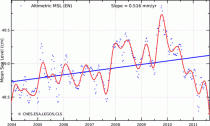
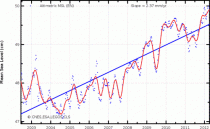
_thumb.jpg)
